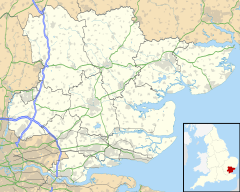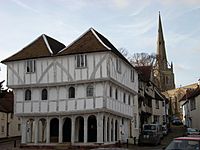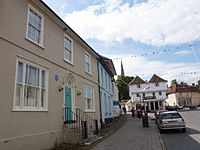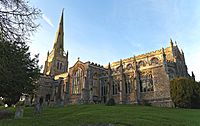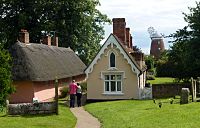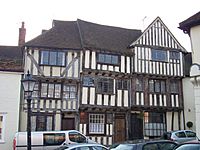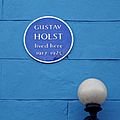Thaxted facts for kids
Quick facts for kids Thaxted |
|
|---|---|
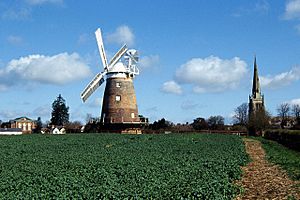 Thaxted Windmill and Church |
|
| Population | 2,845 (2011) |
| OS grid reference | TL615315 |
| Civil parish |
|
| District |
|
| Shire county | |
| Region | |
| Country | England |
| Sovereign state | United Kingdom |
| Post town | DUNMOW |
| Postcode district | CM6 |
| Dialling code | 01371 |
| Police | Essex |
| Fire | Essex |
| Ambulance | East of England |
| EU Parliament | East of England |
| UK Parliament |
|
Thaxted is a town and civil parish in the Uttlesford district of north-west Essex, England. The town is in the valley of the River Chelmer, not far from its source in the nearby village of Debden, and is 97 metres (318 feet) above sea level (where the parish church stands). The town is 15 miles (24 km) north from the county town of Chelmsford, and 5.5 miles (9 km) east from the M11 motorway. The parish contains the hamlets of Cutlers Green, Bardfield End Green, Sibleys Green, Monk Street, and Richmond's Green. Much of its status as a "town" rests on its prominent late medieval guildhall, a place where guilds of skilled tradesmen regulated their trading practices, and its English Perpendicular parish church.
Contents
History
Thaxted appears in the Domesday Book of 1086 as "Tachesteda", Old English for 'place where thatch was got.' Once a centre of cutlery manufacture, Thaxted went into decline with the rise of Sheffield as a major industrial centre. A light railway, the Elsenham & Thaxted Light Railway, eventually opened in 1913, though the railway itself never reached nearer than three-quarters of a mile (1.2 km) from the town, as building earthworks across the River Chelmer proved too costly. With the growth of road transport, the line was closed to passengers in 1952 and closed altogether in 1953. The name of Cutler's Green, a small hamlet about a mile to the west of Thaxted, recalls the trade that yielded the area's early wealth. To the West of Cutler's Green is an area named 'Richmond's in the Wood'.
Demography
In 1829, there were 2,293 people living in Thaxted; in 1848 there were 2,527. At the time of the 1881 census, that figure had fallen to 1,914, and it fell further by 1921 to 1,596.
In 2001, the population had risen again to 2,526. According to the latest 2011 census, the total population of Thaxted stands at 2,845.
Community
Thaxted clubs and societies include Thaxted Morris which was founded in 1911 and is the oldest revival Morris dancing group in England. Thaxted Morris Men hosted the meeting at which the "Morris Ring" was formed as a national organisation in 1934; and continue to host one of their meetings every year: in 2009 this was a celebration of the Ring's 75th anniversary.
The annual Thaxted Festival takes place over four weekends in June and July every year, presenting a programme of musical concerts.
Thaxted football club, the Thaxted Rangers, has a senior team and youth teams.
Landmarks
Notable Thaxted buildings include Horham Hall, Thaxted Guildhall dating from around 1450 and John Webb's Windmill built in 1804.
The parish church of St John, built between 1340 and 1510, is renowned for its flying buttressed spire, which is 181 feet tall and is the only medieval stone spire in the county. It has perpendicular windows and a stained glass representing Adam and Eve. The church, which stands on a hill and overlooks the town, is often referred to as "the Cathedral of Essex". From 1910 to 1942, the vicar was Conrad Noel, known as the 'Red Vicar' because of his well-known Christian Socialism.
Gallery
-
The Manse where composer Gustav Holst lived from 1917 to 1925
-
Dick Turpin's cottage, suggesting the supposed association of the highwayman with Thaxted
Education
Thaxted County Primary School was established in 1878 under the 1870 Education Act. It still occupies the fine Victorian building on the eastern edge of the town built for it in 1880 and is run by Essex County Council.
Thaxted lies within the secondary education catchment area for the Helena Romanes School in Great Dunmow.
There are a number of preschools in the area.
The 1556 Borough Charter provided for setting up a grammar school. This occupied the Guildhall from 1714 until it closed in 1878. A day school, operated by the Church of England, opened in 1819 and was housed in a building funded by Lord Maynard on the Broxted Road. The non-conformists established a rival British School in Bolford Street in 1856. Both schools ceased to operate when the Primary School was established in 1878.
From 1944 to 1962, the Bachad Farm Institute, located on a farm at Bardfield End Green, provided agricultural training to young Jewish refugees, including many from the Kindertransport, as part of a network of hakhshara youth training farms.
Transport
Thaxted once lay on the busy A130 trunk road from Chelmsford to Cambridge which brought large trucks through the centre of the town past the Guildhall and Church. In the 1980s, this route was downgraded to become the B184 road following completion of the M11 motorway and the A120 dual carriageway. Ordnance Survey maps show a roman road running north to south through Thaxted.
Thaxted is connected to the local towns and villages, as well as to Stansted Airport, by local bus services, operated by Stephensons of Essex. Uttlesford District Council runs a community travel service for residents who have difficulty using public transport.
From 1913 to 1952, Thaxted was served by a light railway branch line from Elsenham which ran to a terminus station located about one mile south of the town. The line, the Elsenham & Thaxted Light Railway, was known to locals as the "Gin and Toffee" line because the main investors where a local sweet factory owner and a distillery magnate. Passenger traffic ceased on 15 September 1952 and the line closed definitively on 1 June 1953.
Between 1916 and 1919, Thaxted hosted a Home Defence aircraft landing ground. The unit was equipped with Royal Aircraft Factory BE2 and BE12 variants fighters of No. 75 Squadron until the summer of 1918, and thereafter with Avro 504Ks and Bristol F2bs. The site was decommissioned at the end of the First World War in 1919. The landing ground was located north of Bardfield End Green.
Notable people
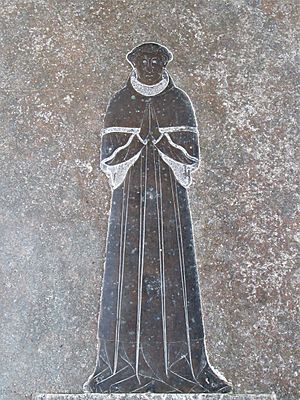
- Robert Wydow or Wedow (c. 1446 – 1505), an English poet, church musician, and religious figure, was born in Thaxted and was vicar of the town from 1481 to 1489. He attended Eton College and King's College Cambridge, and is the first known recipient of a Bachelor of Music degree in England, awarded by Oxford University in 1478 or 1479. Wydow's contemporaries held him in high esteem as a poet and musician, describing him as "an excellent poet", and "easily the finest" of Latin authors of the time. However, only a few lines of his poetry survive and none of his music. The surviving brass in the Parish Church is reputed to be his likeness. Wedow Road, in the town, commemorates him.
- Sir John Cutte (d. 1520), Under-Treasurer to Henry VII and Henry VIII, built Horham Hall on the site of an earlier house. His grandson, Sir John Cutte (1545-1615), hosted Queen Elizabeth I in 1571 (nine days) and 1578 (six days).
- Sir John Alleyn or Allen (c.1470-1544), mercer in the City of London, was born in Thaxted. He served two terms as Lord Mayor of London, in 1525 and 1535. His immediate predecessor as Lord Mayor, Sir William Bailey, serving in 1524, was also from Thaxted.
- Samuel Purchas (1577–1626), English cleric and author, was born in the town. His works are an important source of information about the age of exploration. He graduated from St John's College, Cambridge, in 1600. His most famous work, Hakluytus Posthumus, or Purchas his Pilgrimes, Contayning a History of the World, in Sea Voyages, & Lande Travels, by Englishmen and others (1625) is a massive compilation of accounts by Elizabethan and Jacobean travellers of their journeys around the world. Yet he noted with some irony that "I, which have written so much of travellers and travels, never travelled 200 miles from Thaxted in Essex where I was borne".
- Dick Turpin (1705–39), the famous highwayman, was born in nearby Hempstead and was reputed to have run a butcher's shop in Thaxted. Contemporary biographies claiming that he was born in Thaxted are erroneous; and there is no evidence to support a connection with the cottage in Stoney Lane that carries his name.
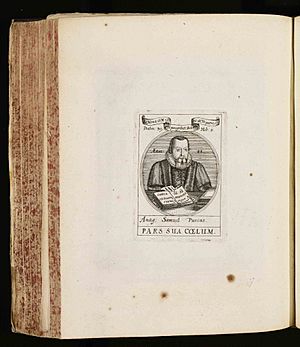 Samuel Purchas never travelled further than 200 miles from Thaxted, the town of his birth, yet became famous for his works on global travel from the age of Discovery. He was a contemporary of Shakespeare.
Samuel Purchas never travelled further than 200 miles from Thaxted, the town of his birth, yet became famous for his works on global travel from the age of Discovery. He was a contemporary of Shakespeare. - John Fell (1733–97), Classical scholar and author, lived in Thaxted from 1770 as minister of the Congregationalist chapel. He was friends with Rayner Heckford, a Saxon scholar, whose family owned Clarence House. Whilst in Thaxted, he tutored the young Richard "Conversation" Sharp (1759-1835), who went on to become a famous wit, literary figure and a Member of Parliament.
- Conrad Noel (1869–1942), Christian socialist, was known as the town's 'Red Vicar', serving in the post from 1910 until his death. He played a key role in the morris dancing revival in the town. He enjoyed the patronage of Daisy, Countess of Warwick, of Easton Lodge.
- Launcelot Alfred Cramner-Byng (1872-1945), sinologist and author, lived at Folly Mill, near Monk Street. He translated many works of Chinese literature.
- Gustav Holst (1874-1934), the British composer of The Planets, lived in The Manse (then called The Steps) in the High Street. His residency is marked by a blue plaque. His daughter, Imogen Holst, also lived in the town in her youth.
- Alec Butler Hunter (1899-1958), textile designer, lived at Market Cross, a fine medieval house next to the Guildhall, from 1944 until his death. He worked for Warner & Sons, the textile manufacturer in nearby Braintree, and was a President of the Society of Industrial Artists. He was an active supporter of Morris dancing revival and the first Squire of the Morris Ring. The Alec Hunter Academy in Braintree is named after him.
- Sir George Binney DSO (1900– 72), Arctic explorer, lived at Horham Hall from 1946 to 1969.
- W. E. Shewell-Cooper (1900–82), gardener and pioneer of organic gardening, lived and worked at Prior's Hall, outside the town, from 1948 to 1960, where he ran a training college promoting organic horticulture.
- Donald Hall (1928-2018), American poet and writer, spent a year in Thaxted between 1959 and 1960, during which time he wrote his collection of poems, A Roof of Tiger Lilies, and his short story collection, A String Too Short To Be Saved. His poem, An American in an Essex Village, describes a walk around the town at that time, including the church and the then derelict windmill whose "ruin appals only an eye which invents a landscape which needs it."
- Evelyn Anthony (Evelyn Bridgett Patricia Ward-Thomas) (1926-2018), novelist, lived at Horham Hall from 1968 to 1976 and again from 1982 to her death. Her most successful novel was The Tamarind Seed, which was made into a feature film.
- Diana Wynne Jones, author of Howl's Moving Castle and other novels, was raised in the town.
- Genista McIntosh, Baroness McIntosh of Hudnall, the Labour life peer, lived in Thaxted from 2002 to 2015. She spoke in praise of Thaxted Parish Church in a debate in the House of Lords in 2014.
Images for kids
-
The town crest, depicting two crossed swords, derives from the crest of the cutlers' guild, a reference to the once thriving cutlery industry in the town.
See also
 In Spanish: Thaxted para niños
In Spanish: Thaxted para niños


